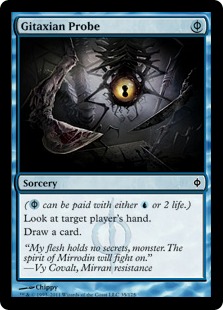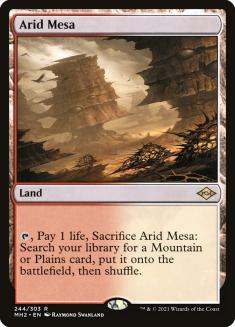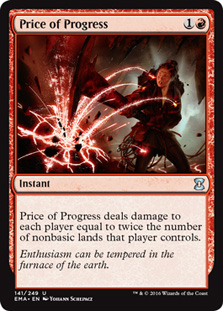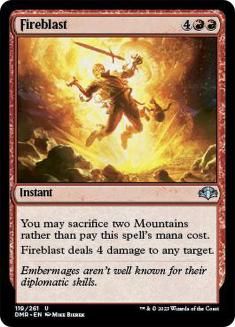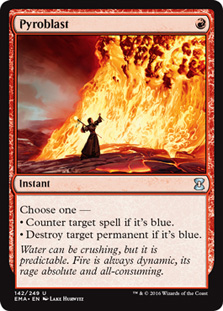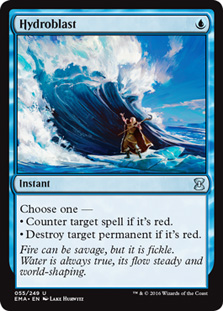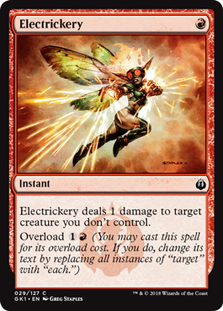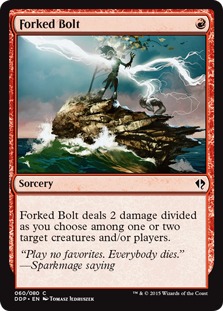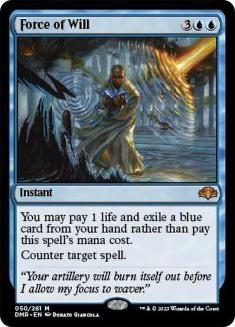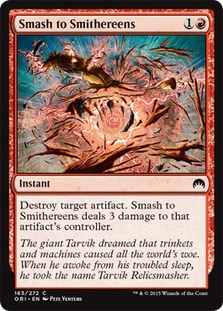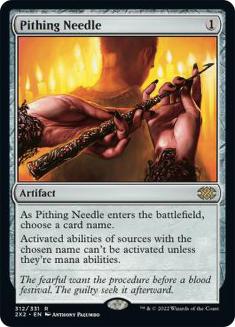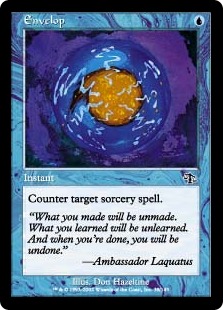After my failure with Deathblade at Eternal Champs, I tried to go into full testing mode for the upcoming Legacy Grand Prix. Unfortunately, my plan was
spoiled due to a week of being marginally too sick to work hard, but I managed to get work done.
Starting from the obvious top:
I refused to play Storm for all the reasonsI talked about last year. It’s not like the deck got any better. Even though people are cutting their
counterspells in U/R Delver, they are still playing a deck with a dozen cantrips and a very fast clock. Delver can easily kill on turn 4 and sometimes even
on turn 3 and typically can do so while finding a Force of Will and sometimes protecting it with Brainstorm. Even a Red Elemental Blast or Pyroblast can be
obnoxious by shutting down your early hand sculpting, and if they make a trade or two, it can be difficult to keep the critical mass of combo pieces in
hand while spending cards to fight through Force of Will or hate bears.
I also didn’t want to play another combo deck. Show and Tell or High Tide in a format of maindeck Pyroblast? Get real. What about a non-blue incentive card
in combo like Drew Levin was advocating? Guess what? There aren’t really any. Or at least any good ones. Maybe there was some crazy card shop basement
style multi-combo mono-black deck, but I certainly didn’t have a list.
To be fair, a lot of this is related to a general shift in the way the game is played. I started playing Legacy in 2010, and the game was just different.
There was also a big inability of less expensive cards to impact the lategame. The threats were either cheap and low-impact like Kird Ape, or expensive and
game-breaking like Jace, the Mind Sculptor. Because it was so easy to trump the cheap threats, it was typically right to create a showdown scenario where
you won the fight over your trump and the game ended. The rare threat that played well outside of its designated game stage, like Tarmogoyf or Wild Nacatl,
was so important that it would drive the entire fair half of the metagame. Storm was simply on a completely different level both in terms of sculpting this
boardstate and in terms of the threat it presented, and for a long time I didn’t even consider anything else to be remotely close to the same level.
But the power level of cheap threats has risen over the years. Stoneforge Mystic was the start of it all, but Delver of Secrets, Deathrite Shaman, Young
Pyromancer, and Monastery Swiftspear are among the new comers that redefined this trend. These are cards that are very capable of killing your opponent
over or through larger threats. If anything, the threat distribution is similar to how the four-drop, five-drop dichotomy worked in Standard last year. The
larger threats people play aren’t that much better at killing your opponent. They are mostly cards with massive interaction value added like Jace, the Mind
Sculptor or Vendilion Clique or massive fair trump value like True-Name Nemesis. Back to the cheap threats, it means you can afford to just run something
out there and lose it because you didn’t commit a lot of resources to it.
This changes how midrange mirrors are fought, but it importantly makes showdown strategies way worse. If your opponent can just cast their Delver of
Secrets and lose it without caring and leaving up a ton of interaction, but you need to commit a ton of mana or multiple cards into your win attempt, they
can just build the rest of their deck to fight your fight better than you can. Every deck is full of card manipulation, cheap answers, and threats that fit
well into this shell. You aren’t playing against people tapping out for Rhox War Monk or who just sit there for twenty turns while you sculpt a perfect
hand anymore, and as a result, combo in particular has become far worse over the years.
That all said, Dig Through Time in a combo-control deck like Modern Scapeshift seemed awesome, but I couldn’t figure out a combo I was satisfied finding.
You want a non-time critical instant kill where they die as soon as it happens regardless of generic creatures in play or your life total, but there aren’t
a lot of those that don’t get Red Elemental Blasted. Most of the ones that don’t aren’t very synergistic with Dig Through Time as they are permanent-heavy,
like Painter’s Servant plus Grindstone. The worst part is that the best combo to find is Helm of Obedience plus Rest in Peace, but you can’t actually think
you want to play Rest in Peace alongside Dig Through Time.
So I pushed down the route of pure control.
The U/W Control and Stoneblade decks were fine, but they had multiple flaws. In pre-board games they were not especially cohesive and often would just draw
the wrong half of their deck. It would seem like this wasn’t an issue with Brainstorm and Ponder, but because all the other decks have Treasure Cruise or
Dig Through Time, every game goes even later than expected; you are constantly forced to draw the good half of your deck even after you go twenty cards
deep. In post-board games, Stoneforge Mystic was terrible. In fact, it was just bad against half the decks in Game 1 as well. If they just don’t interact
with the card it’s great, but that is a rare occasion. Leaning on Batterskull to win game 2s against Smash to Smithereens is not where you want to be.
Note that in the mean time I also tried Elves and Death and Taxes. Elves was just not good against Delver, and neither was Death and Taxes. You would think
that Spirit of the Labyrinth and Thalia, Guardian of Thraben would beat up on the heavy cantrip deck, but that’s only half their deck. Your deck is great
against the blue half, but their red half crushes your deck. Considering they will get a chance to fire off a cantrip or two before you start locking them
out, odds are they will find the red half. Unlike what I mentioned with Stoneblade, running out of the good half of your deck isn’t an issue, as A) they
will be out of cards and dead and B) the “bad half” of your deck is just good blue cards. Maverick was close to playable because Knight of the Reliquary
was unbeatable for Delver decks, but anyone who could kill your larger creatures would Treasure Cruise or Dig you into oblivion.
Which brought me back to “play the best deck,” mostly because it was the only thing that just kept winning easily.
The list I played was based off of a list Caleb Durward posted last week with a few minor tweaks.
Creatures (11)
Lands (15)
Spells (34)

U/R Delver isn’t a traditional Delver deck. It’s not about the typical resource denial game of Stifle, Wasteland, and Daze.
What you are doing with U/R Delver is about creating and maintaining velocity. You keep chaining spells until you have reached a boardstate where your
opponent is dead. If they have interaction to stop your primary assault, you have the ability to manipulate your deck, stop their card advantage, and bury
them in even more threats thanks to Treasure Cruise and the card advantage generated by Young Pyromancer.
In short, U/R Delver is just a Storm deck for the future, with threats that don’t require a massive resource commitment.
Here are my thoughts on the list specifics. For reference, some of these are largely colored by my results at the Grand Prix of wins against 3 U/R Delver
mirrors (1 with Stifle–Wasteland, 2 with Daze), 1 Sultai Delver, 1 Elves, 1 Burn, 1 Death and Taxes, and 1 Miracles. Losses were against 2 Stoneblade (1
Jeskai, 1 Deathblade), 1 Jeskai Delver, and 1 Dredge:
11 Threats
(4 Delver of Secrets, 4 Monastery Swiftspear, 3 Young Pyromancer):
Caleb mentioned that he cut a threat, as it was very easy just to flood out on them. In my experience, that was very true. Threats don’t produce card
velocity or interaction. Eleven was the right number, but in retrospect I think he cut the wrong one.
Shave a one-drop, play a fourth Pyromancer.
That card is cited as “completing the cycle” of Stoneforge Mystic, Snapcaster Mage, Dark Confidant, and Tarmogoyf, but it might just be the best one. This
is a creature with built-in Storm.
A big part of Young Pyromancer is managing the card to get the maximum amount of value against removal. If they let it live, odds are you aren’t going to
lose. Your goal should be to extract some amount of value out of the exchange between it and Swords to Plowshares or Lightning Bolt. If you get a Sprout
worth of value out of the immediate Gitaxian Probe on turn 2, that’s solid. If you get a Raise the Alarm of value out of a cantrip and an in response
Lightning Bolt, that’s great. And if you get a Hordeling Outburst by instigating a Force of Will fight….
11 Burn Spells
(4 Lightning Bolt, 3 Chain Lightning, 2 Forked Bolt, 1 Fireblast, 1 Price of Progress)
These are your endgame. You will draw lethal burn off your cantrips given enough time and they will die.
I was generally happy with this split. Chain Lightning can be a bit of a liability in the mirror match due to the bonus text, while the second Forked Bolt
opens up a lot of blowout potential at little cost. Fireblast isn’t a card you always want, but it does a lot of good work when you do. I wish I could say
the same for Price of Progress, but the card was more awkward than good. It wins some games that would otherwise be completely unwinnable, but it’s very
situational. I didn’t particularly regret having the card, but it’s a flex slot that may have been better as a second Preordain to increase consistency.
That said, Fireblast and Price of Progress were the most cut cards in the deck, but that may be because I played a lot of small creature matchups like the
mirror where you just make all of your cards great at interacting or attacking. Forked Bolt also came out a lot against anything that wasn’t in the above
category.
4 Counter Magic
(4 Force of Will):
Really, this is more about the following numbers: 0 Daze, 0 Pyroblast.
This deck is proactive. You want cards that do things, and you especially want cards that do things at all stages of the game. Daze does nothing in the
mid- and post-Cruise phases of the game where you are positioning over your Ancestral Recall and finding the lethal assembly of cards, while Pyroblast only
works in the mid-Cruise game where you are trying to stop their Cruise or force yours through a Force of Will.
Force of Will, on the other hand, works all the time. It counters early threats, Treasure Cruises, and counters, and post-Cruise protects whatever you
establish. Caleb only had three copies, but it seems wrong to me to do that. The worst case scenario is that the first copy pitches the second, and there
are so many cases where having a Force of Will is the best thing possible.
One thing worth noting is that there is a real balance with casting your cantrips and leaving up Force of Will. Often you are left with a Ponder or
Gitaxian Probe and Treasure Cruise as your blue cards and are given a “good opportunity” to cast the worse cantrip to build into Cruise. More often than
not you are better off just keeping the worse cantrip around as Force fodder so that you can keep the game-breaking Treasure Cruise. Also note that Force
of Will has a mana cost that can be paid in the post-Cruise phase of the game. Over twelve rounds I had a handful of situations where I was setting up a
one-drop spell with a five mana counter backup.
For the record, I often boarded down to three Forces in blue mirrors, but some of that comes with the post-board territory. Not only do you get to replace
them with Pyroblasts to handle a lot of the cards you are trying to Force, but their increased Pyroblast density means that Forcing a key spell is more
likely to result in you being on the wrong side of the exchange.
17 Card Draw
(4 Brainstorm, 4 Ponder, 4 Gitaxian Probe, 1 Preordain, 4 Treasure Cruise):
Just this number really shows what I’m talking about. A quarter of your deck is specifically geared towards chaining into more of your deck.
Caleb had a Dig Through Time as the fifth dredge card draw spell, but I really disliked the idea. Just like you can flood on threats, you can flood on
delve spells, and flooding on those cripples your ability to cast the first one. Dig is really powerful with singleton burn spells to find, but the raw
power and efficiency of Cruise are what this deck is built to take advantage of.
Worth noting: some people wanted to cut down on Gitaxian Probe. Don’t. It’s too important in the setup of Cruise and Pyromancer. I was boarding one out in
the mirror and two or so out versus Burn, as you can’t really afford to pay life on multiples (or any versus Lava Spike), but I never cut it outside of
those matchups.
I also would board out a Treasure Cruise against faster decks unless I was heavy on trading cards (i.e. you want four against Elves but not Storm) or if I
was concerned about getting caught with multiples against a Deathrite Shaman (mostly Sultai Delver).
17 Land
(3 Arid Mesa, 4 Scalding Tarn, 4 Polluted Delta, 4 Volcanic Island, 1 Island, 1 Mountain):
I definitely lost some games to flooding out, but I won a lot by hitting my first three land drops. I also was able to play through Wasteland/Stifle draws
very easily. Looking back on my experiences with Storm when I first played that deck with twelve cantrips, seventeen is definitely the right number of
lands for hitting the first three drops, which seems slightly more important than being a little more live on your draws lategame when the rest of your
deck is maximized for that.
That said, if they didn’t have land destruction, I almost always boarded out a land. Again, just like Storm: If you aren’t trying to play around their
mana-constricting spells, you can board down on mana.
Also, only having six lands that make mana was definitely correct. Fetchlands are lands that are also Simian Spirit Guides in “Treasure Cruise: The
Format.”
It’s also a very marginal consideration that you should be playing matching tri-color fetchlands (i.e. Polluted Delta and Bloodstained Mire, or Arid Mesa
and Flooded Strand, or Wooded Foothills and Misty Rainforest). I played the ones I found first.
Sideboarding:
3 ‘Blasts
(2 Pyroblast, 1 Blue Elemental Blast):
Pyroblast is Pyroblast over Red Elemental Blast as it can be cast without a blue target to trigger Monastery Swiftspear, Young Pyromancer, or just to store
a “mana” for Treasure Cruise. Blue Elemental Blast is Blue Elemental Blast as your Sneak and Show opponent can’t Misdirection a Blue Elemental Blast
targeting a Sneak Attack as there is no other valid red target, while a Hydroblast can legally be redirected to the blue Misdirection on the stack.
Caleb is right that overloading on Pyroblast is a very big issue to watch for in all of the blue matchups. Two was pretty ideal, and even with two I found
myself with a dead one from time to time. On the flip side, I’m not sure there is a maximum number of Blue Elemental Blasts in the matchups I want that
card. It always has a board relevant card to trade for, whether it’s Monastery Swiftspear or a Lightning Bolt. If I played the deck again I would
definitely find room for a second Blue Elemental Blast.
3 Counterspells
(1 Flusterstorm, 1 Envelop, 1 Spell Pierce):
The mix was to be super flexible against all of the possible threats. Flusterstorm is less live against something like Miracles, but it is crushingly
impossible for the decks it beats to play around. Envelop hits certain things super hard, and Spell Pierce was a catch-all.
In the end, I was most impressed by Envelop. I’m unsure I want more, but it was tagging all sorts of awesome things. Versus Miracles it always has a target
that matters, whether it’s a miracle or a Ponder. Against combo it tags Tutors and Show and Tell. Even against Elves it hits Green Sun’s Zenith, Natural
Order, or Glimpse of Nature, otherwise known as all the good ones.
I was least impressed by Flusterstorm, but it plays a role. If you don’t expect to have to fight Storm, I would cut it for another Spell Pierce or some
similar effect that can interact with the card Sneak Attack.
4 Artifact Hate
(3 Smash to Smithereens, 1 Pithing Needle):
Smash was great. As I mentioned, Stoneforge Mystic gets miserable post-board, and part of that is because you can’t afford to cut it, but you get extremely
punished by this exact card. It can sit in your hand for a bit, but because you have Treasure Cruise you can continue to play games against Stoneblade
despite being down a card. At some point, they get backed into a corner and have to play their equipment and you can cash in on a good trade.
The Pithing Needle was mediocre at best. While it was excellent against Death and Taxes and Miracles, I felt like I overestimated its applications outside
of those matchups. I thought it would be good versus Elves, then I realized you are trying to keep their material off the board to manage Gaea’s Cradle and
Natural Order, and that Needle would just leave them with a relevant 1/1. I thought it might be good against Stoneblade decks, but Batterskull is still a
4/4, and it doesn’t fight the rest of the relevant fights. I thought it might shine against some combo decks, but in reality it is just super situational
except against combo decks that you should shred on the basis of inconsistency, like Painter. Unless I had a huge fear of Miracles that I couldn’t answer
in other ways, I would not play the card again.
2 Removal
(1 Electrickery, 1 Submerge):
Electrickery did exactly what it was supposed to do. Early on, I considered a Forked Bolt over it, but in the end it turned out Electrickery exchanges
being slightly worse but insane in the scenarios Forked Bolt is insane, for being completely absurd in some scenarios Forked Bolt could never dream of
coming close.
Submerge was sweet when I played against Sultai Delver specifically for dealing with Tarmogoyf, but I ran into a bigger issue in other rounds. It turns out
that Kor Firewalker is an actual piece of hate that matters, and as a result, Dismember would be much better. It’s not like you can’t keep a Tarmogoyf to a
4/5 in this deck, so it would still die to -5/-5 almost all the time. It’s also possible that a much better card exists that handles even more scenarios in
better ways.
3 Random Hate
(2 Grafdigger’s Cage, 1 Price of Progress):
Grafdigger’s Cage hits Elves, Dredge, and Reanimator. Not much else to say besides the card is awesome and insanely broad in application.
The Price of Progress specifically hits Lands and some blue decks that are straining their mana. I was unable to fully exercise the card, but that might be
more of a result of the matchups I played than the card itself.
If I had to run the exact same tournament over again, I would play a second Preordain main over the Price of Progress; and a Blue Elemental Blast, a
Dismember, and a card to be determined over the Price of Progress, Submerge, and Pithing Needle. Note that a lot of that is just me judging based on the
exact matchups I played. If I had played against Lands, maybe I would want the Price of Progresses. If I played more Miracles players, maybe I would be
wanting a Null Rod in addition to Pithing Needle. The amount flexibility for local metagames is a huge thing for this deck moving forward.
Some sample sideboard plans for the matchups I faced:
VS U/R Delver
Out:
In:
Minus four non-interactive cards, plus four interactive cards. Interact better than they do, position better than they do. Resolve Cruises and don’t get
blown out. I can’t really explain it in an abstract sense, but if I walked through a game it would probably become rapidly clear the kinds of plays I’m
talking about.
I don’t like soft counters here as I’m trying to unconditionally position my fights, and Flusterstorm loses the fight over Cruise by itself and loses the
fight over Young Pyromancer.
It’s marginal, but it’s very possible you want to cut a Polluted Delta over an Arid Mesa.
VS Stoneblade
Out:
In:
If they are on Deathblade, boarding is a bit different. I shave a Preordain, the Fireblast, and one other pseudo-random card to fit both Price of
Progresses in and keep a Forked Bolt to fight Deathrite Shaman. That said, against the stockish Rudy Briksza builds, you don’t want Forked Bolt. Seven
answers to Stoneforge Mystic is more than enough, and drawing too many kills your velocity.
VS Miracles
Out:
In:
I’m not sold on Spell Pierce here as it seems to get dead fast, but it can interact with Top, which is a big deal. It’s also possible that boarding out one
Monastery Swiftspear is right as it is easily the worst threat; you have to commit a lot to it to deal relevant amounts of damage.
Most of the other matchups are far more linear, but the general framework should help apply lessons elsewhere. If you are boarding more than five cards,
you are either having to massively change your deck or you are risking diluting it. Board out less Force of Wills than you think you should unless you
clearly don’t want the card (Aether Vial). Board out the conditional burn spells if you are interested in killing a bunch of creatures, board out Forked
Bolts if you aren’t. Board out a fetchland if they aren’t a Wasteland deck.
Would I play this deck again? Absolutely and within four cards. The core was absolutely perfect. That all said, I think Brian Braun-Duin really cracked it
with his deck choice and his win. He kept a lot of the fluidity of Delver while upscaling his deck to trump mirror matches. Bob Huang was on a similar
route. I think U/R Delver certainly has upsides compared to the three-color lists against a fair number of decks, but the Jeskai lists were very well
metagamed.
The one thing I know moving forward: I’m playing Treasure Cruise or Dig Through Time until someone tells me I’m not allowed to. Like I always say, I play
decks that are better than I am, and both of those cards are certainly better than anything else you can do in the format.

